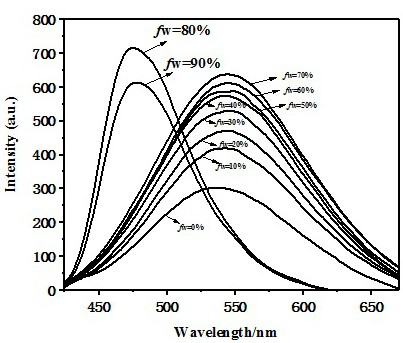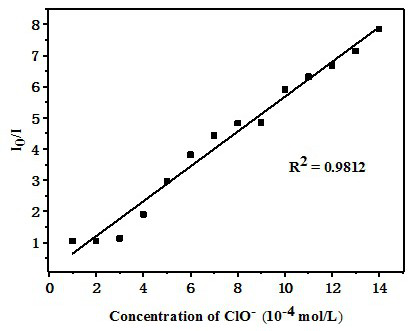Method for detecting hypochlorite by tetra (4-aminobiphenyl) ethylene and application
An aminobiphenyl and hypochlorous acid detection technology, applied in chemical instruments and methods, measuring devices, fluorescence/phosphorescence, etc., can solve the problems of high cost, tissue damage, complicated operation, etc., and achieve high accuracy.
- Summary
- Abstract
- Description
- Claims
- Application Information
AI Technical Summary
Problems solved by technology
Method used
Image
Examples
Embodiment
[0020] The method of utilizing tetrakis (4-aminobiphenyl) ethylene to detect hypochlorite of the present embodiment, the specific steps are as follows:
[0021] AIE experiment of tetrakis(4-aminobiphenyl)ethene compound. The specific structural formula of the tetrakis (4-aminobiphenyl) ethylene compound used in this embodiment is as follows Figure 5 shown. Dissolve the above-mentioned tetrakis(4-aminobiphenyl)ethylene compound in tetrahydrofuran (THF) to make a 400µM solution as the mother solution, take ten 10ml glass bottles, numbered 0-9 respectively, and add 1ml of the above mother solution to each bottle , and then add deionized water at the ratio of 0, 10%, 20%...90% respectively, and finally add tetrahydrofuran to make 10ml mixed solutions respectively. Test the fluorescence intensity of each group of mixed solutions on a fluorescence analyzer, such as figure 1 As shown, it is the AIE fluorescence curve of the mixed solution made of the above-mentioned tetrakis (4-a...
PUM
 Login to View More
Login to View More Abstract
Description
Claims
Application Information
 Login to View More
Login to View More - Generate Ideas
- Intellectual Property
- Life Sciences
- Materials
- Tech Scout
- Unparalleled Data Quality
- Higher Quality Content
- 60% Fewer Hallucinations
Browse by: Latest US Patents, China's latest patents, Technical Efficacy Thesaurus, Application Domain, Technology Topic, Popular Technical Reports.
© 2025 PatSnap. All rights reserved.Legal|Privacy policy|Modern Slavery Act Transparency Statement|Sitemap|About US| Contact US: help@patsnap.com



